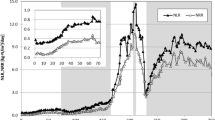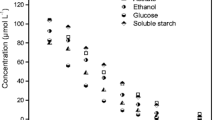Abstract
Mixed microbial consortia in the form of aerobic microbial granules (AMG) capable of xenobiotic degradation can be developed from activated sludge or by adaptation of microbial granules pre-grown on labile carbon sources. Both of these approaches were investigated for the cultivation of AMG capable of p-nitrophenol (PNP) biodegradation. Attempts to cultivate AMG from activated sludge using PNP as the sole carbon source were not successful due to poor microbial growth and washout of the inoculated activated sludge. As part of the second approach, parallel sequencing batch reactors (SBRs) were inoculated with pre-grown AMG and operated by feeding both acetate and PNP together (RA), PNP alone (RB) or acetate alone (RC). Acetate/PNP mineralization and nitrification were monitored in the three SBRs. PNP biodegradation was quickly established in both RA and RB. PNP removal rates were found to be 47 and 55 mg g VSS−1 h−1 in RA and RB, respectively. PNP biodegradation during the SBR cycle consisted of distinct lag, exponential and deceleration phases. However, with higher concentrations of PNP (>50 mg l−1), disintegration of granules was observed in RA and RB. When PNP was the sole carbon source, it inhibited the development of aerobic granules from activated sludge and caused disintegration of pre-cultivated aerobic granules. When PNP was the co-substrate along with acetate, the structural and functional integrity (including nitrification) of the granular sludge was maintained. This report highlights the importance of a labile co-substrate for maintaining the physical and functional integrity of granular sludge, when used for toxic waste degradation.







Similar content being viewed by others

References
Trapido, M., & Kallas, J. (2000). Environmental Technology, 21, 799–808.
USEPA (2007) No. DW-89939822-01-0.
Eckenfelder, W. W. (1989). Industrial water pollution control. New York: McGraw-Hill.
Spain, J. C., & Gibson, D. T. (1991). Applied and Environmental Microbiology, 57, 812–819.
Xing, X., Inoue, T., Tanji, Y., & Unno, H. (1999). Journal of Bioscience and Bioengineering, 87, 372–377.
Bhatti, Z. I., Toda, H., & Furukawa, K. (2002). Water Research, 36, 1135–1142.
Tomei, M. C., Annesini, M. C., Luberti, R., Cento, G., & Senia, A. (2003). Water Research, 37, 3803–3814.
Tomei, M. C., & Annesini, M. C. (2005). Environmental Science & Technology, 39, 5059–5065.
Yi, S., Zhuang, W., Wu, B., Tay, S. T. L., & Tay, J. H. (2006). Environmental Science & Technology, 40, 2396–2401.
Di Iaconi, C., Ramadori, R., Lopez, A., & Passino, R. (2007). Industrial and Engineering Chemistry Research, 46, 6661–6665.
Nancharaiah, Y. V., Joshi, H. M., Mohan, T. V. K., Venugopalan, V. P., & Narasimhan, S. V. (2006). Current Science, 91, 503–509.
Nancharaiah, Y. V., Schwarzenbeck, N., Mohan, T. V., Narasimhan, S. V., Wilderer, P. A., & Venugopalan, V. P. (2006). Water Research, 40, 1539–1546.
Nancharaiah, Y. V., Joshi, H. M., Hausner, M., & Venugopalan, V. P. (2008). Chemosphere, 71, 30–35.
Yarlagadda, V. N., Kadali, R., Sharma, N., Sekar, R., & Vayalam Purath, V. (2011). Applied Biochemistry and Biotechnology. doi:10.1007/s12010-011-9509-3.
Adav, S. S., Lee, D. J., Show, K. Y., & Tay, J. H. (2008). Biotechnology Advances, 26, 411–423.
Xiong, Y., & Liu, Y. (2010). Applied Microbiology and Biotechnology, 86, 825–837.
Saville, R. M., Rakshe, S., Haagensen, J. A. J., Shukla, S., & Spormann, A. M. (2011). Journal of Bacteriology, 193, 3257–3264.
Ray, P., Oubelli, M. A., & Loser, C. (1999). Applied Microbiology and Biotechnology, 51, 284–290.
USEPA (1979). 353.3. U.S.
APHA. (1998). Standard methods for the examination of water and wastewater. Washington, DC: APHA.
Lane, D. J. (1991). 16S/23S rRNA sequencing. In E. Stackbrandth & M. Goodfellow (Eds.), Nucleic acid techniques in Bacterial systems (pp. 115–175). Chichester, UK: Wiley.
Muyzer, G., de Waal, E. C., & Uitterlinden, A. G. (1993). Environmental Microbiology, 59, 695–700.
Low, E. W., Chase, H. A., Milner, M. G., & Curtis, T. P. (2000). Water Research, 34(12), 3204–3212.
O’Toole, G., Kaplan, H. B., & Kolter, R. (2000). Annual Review of Microbiology, 54, 49–79.
Acknowledgements
SE is thankful to the University Grants Commission (UGC), Government of India, for providing Junior Research fellowship.
Author information
Authors and Affiliations
Corresponding author
Rights and permissions
About this article
Cite this article
Suja, E., Nancharaiah, Y.V. & Venugopalan, V.P. p-Nitrophenol Biodegradation by Aerobic Microbial Granules. Appl Biochem Biotechnol 167, 1569–1577 (2012). https://doi.org/10.1007/s12010-012-9594-y
Received:
Accepted:
Published:
Issue Date:
DOI: https://doi.org/10.1007/s12010-012-9594-y



